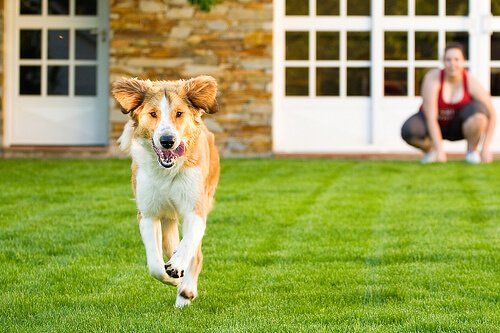How to Train Your Dog Not To Run Away from Home

It can be very stressful when your dog escapes, because when a dog roams the streets it can be harmful to his health. Exercising with your pet, is a good way to get rid of this habit.
A dog might try to run away from home for many reasons, but you can stop this behavior by training him. Below, you can learn about some tips to help you train your dog not to run away from home.
Training your dog not to run away from home
Roaming the street can pose a serious threat to the health and well-being of your dog. When he escapes, a dog is exposed to several microorganisms, car accidents, or being taken by someone else.
Say “no” to violence and “yes” to positive reinforcement
Certain things your dog does might anger you, but you should never use violence as a way to resolve any unwanted behavior. You should consider the fact that you can cause aggressive reactions and traumatic experiences in your dog.
Therefore, it’s also necessary to point out that your aggression can cause the dog to escape because he feels frightened, unsafe, or unwanted in his home.

That’s why you must prioritize positive reinforcement in training your dog. Rewarding good behavior plays an important role in stimulating their cognitive function and strengthening their self-confidence. A dog who feels his owner’s recognition and affection will rarely escape because he feels fear or insecurity.
Associating his name with positivity
If you use your dog’s name to scold him, or when you’re angry, your dog will associate his name with negative experiences. However, this doesn’t mean you shouldn’t train him or establish limits when you raise him.
You should use the classic, flawless “no” to point out any inappropriate behavior. Only use his name for receiving rewards, playing, and petting.
That way the dog will respond more to your calls and will listen to you if he tries to escape. However, if he associates his name with your anger or a punishment, he will rarely come home when he hears it. This is the first step of applying positive reinforcement when you train your dog and it’s one of the most important ways to stop your pet from escaping.
Watch your non-verbal language
Dogs are very sensitive and easily perceive changes not only in your tone of voice, but also in your body language. Therefore, they can perceive your moods, mood changes, and emotions.
If your dog tries to escape, it’s important to monitor your body language and tone of voice. In such moments, it’s best to crouch down and call the dog calmly, but sternly. If that doesn’t work, plan “B” is to run in the opposite direction, as if you’re inviting him to play and go on a new adventure together.
Affection, control, and getting the family involved
A dog who feels loved by his family and a part of the home will not have any reasons for escaping. On the contrary, an animal who’s exposed to violence, loneliness, or his owners’ indifference will run away in search of a better life.
Regular physical activity
Dogs who have a sedentary routine or who are always indoors might run away in order to run, play, and feel free. That’s why regular exercise is important when you want to train your dog not to run away from home.

A great tip is to take advantage of your puppy’s first walks to teach him to play “hide and seek”. In the beginning you can just let him loose and hide behind a tree. You’ll have to call him until he finds you.
Finally, to reinforce his good behavior, it’s important to offer him treats, compliments, pats, and games. That way, your dog will associate losing sight of you with the need to find you.
Train your dog to not run away from home: sterilization
Satisfying sexual impulses is one of the main reasons why dogs escape, especially sexually active males. In other words, many dogs escape to satisfy their sexual appetites or physiological needs.
In those cases, sterilization is the most effective method to stop your dog from running away. Most dogs adopt a calmer personality and their sexual appetite is reduced after the procedure.
However, the removal of sexual organs doesn’t eliminate sexual desire. A sterilized dog can also escape in search of self-satisfaction, or for other reasons. Therefore, sterilization doesn’t rule out the need to train your dog not to run away from home.
